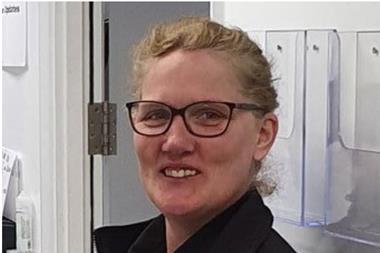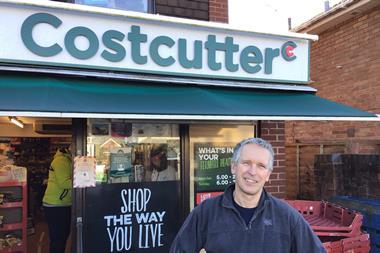Richard Inglis and his team are more available for their customers thanks to behind-the-scenes technology saving them both time and money
Paperwork is a thing of the past at Co-op Welcome Frobisher House, where store owner and self-confessed geek Richard Inglis has tapped into technology in order to make life easier for him and his team. The store picked up Convenience Store’s Best Use of Technology Award at the Convenience Retail Awards earlier this year, and it isn’t hard to see why.
Richard manages Parkview Retail - which comprises three Welcome Co-op stores in Southampton - from ‘the cloud’. This means that the business is run using a network of remote servers hosted on the internet to store, manage and process data, rather than a local server, or a personal computer.
In October, the store installed a Parim workforce management software system. A tablet is positioned by the store entrance so that staff can clock in and out, or they can use their mobile phones to do this. But the system is much more than a glorified register.
Richard opted for a cloud-based system, rather than Microsoft Excel, because he says it eliminates the administration element, allowing different people within the business to see different levels of information, so a member of staff could check the details relevant to them - such as working hours - while Richard can see the pay details of each staff member.
Store facts
Store size (sqft): 2,200 sqft sales (total including store/office 2,971 sqft)
Weekly Turnover: £45,000 (£54,000 including services)
Planning staff shifts is now quick and easy and Richard claims that staff love the simplicity of the system. “Before, we used to have paper rotas and I’d put them into an Excel spreadsheet, which I would colour code,” says Richard. “The amount of times I’d get pay queries was ridiculous! Now, people can just check on the system themselves.”
Before, if staff booked holiday, Richard would have had to call around to get cover and manually remove that member of staff from the rota. Now, the whole team can view the schedule and organise holiday cover at the click of a button.
And if the time savings alone aren’t impressive enough, the cost savings are hard to argue with. Richard used to spend £68 a week per store on staff planning, data entry and payroll entry etc, which equated to £3,500 a year per store. With the Parim system, the cost has been more than halved to £28 a week, or £1,500 a year, including the cost of the software. He adds that the system will have paid for itself within a year.
Technology has also improved the store’s cash handling. Cashing up used to take over an hour every day, but now it takes less than 30 minutes thanks to a combination of electronic cash counters and a cashing-up database. “You have to look at where managers are spending their time and whether this is the best use of their skill,” says Richard. “Cashing up is now just a case of entering figures, rather than counting all the coins and getting out a calculator.” The results are then immediately emailed to the management team so that there is an instant record of what’s going on in store.
Chiller management is another area that has been made easier thanks to technology. A Resource Data Management (RDM) panel linked to probes in the chillers enables Richard to see how they are functioning at anytime, anywhere, from his mobile phone. “We manage the temperature on individual cases, so meat can be set at 3.5°C while fruit and veg can be set at 7°C,” he says. “The alcohol and soft drinks chillers are on timers, too, so they don’t chill overnight. The RDM panel also controls lights on the chiller cases, so the chiller lights turn off at 11pm to save energy.”
Meanwhile, motion sensors are used on lighting in the rear store rooms and offices which means that people don’t have to worry about turning lights on and off.
Having remote access means Richard can react quickly to problems, too. “We had a slow gas leak in a walk-in chiller, so it didn’t fail instantly, but looking at the graph you could see a slow increase in temperature,” he explains. Because Richard could identify an issue in advance of the chiller completely failing, he was able to save all of the stock, which was valued at £3,000.
Richard also has an app set up on his phone to enable him to remotely manage the store’s security system. He once had a 3am call from the alarm company, so he immediately logged into the CCTV remotely and could see that a stack of crisps had fallen down and triggered the alarm. He could then remotely reset the alarm from his phone without having to visit the store.
The shop also embraces a host of customer-facing technologies such as two large screens: one by the chillers in the first aisle as soon as you walk through the door; and the second by the soft drinks and alcohol as you walk towards the checkout. These are used to flag up key services and deals in-store. They can also show local train times (the train station is opposite), cruise ship times (Southampton port is nearby) and Twitter feeds from daily papers. The screens are updated every three weeks in line with promotions, and then any other community news is added when appropriate.
Customers are offered free wi-fi in store. “This is an opportunity for the shop to build customer loyalty and drive sales by using the store’s webpage as the landing page, so shoppers are immediately linked to the store and what’s on offer,” says Richard. He uses Google analytics to track visitors to the website and where they’ve come from.
The store works with Big Deals Local (Big DL), which helps shoppers find the deals that they want from shops on the high street. As shoppers walk through the door, they will automatically connect via Bluetooth to BigDL and see the promotions available.
In addition, a beacon is located on the shop door, which will cause people’s phones to ‘ping’ as they walk past and alert them to the store and the deals on offer.
Richard has clearly taken time to get to grips with the technologies he uses, but he is confident this is the way forward. “I’ll put 10 hours into understanding the technology if it saves me two minutes every day,” he says. “Using this technology means I can be home to pick my kids up from school and then work from home. In this job you work long hours, so if I can spend more time at home, I will.
“It’s about making the business work for you, rather than the other way round.”
Best Use of Technology
In March, Co-op Welcome Frobisher House was awarded Best Use of Technology at the Convenience Retail Awards. “This year’s finalists all demonstrated a commitment to innovation and effective use of technology in store,” says Stephen Burnett, managing director of The Retail Data Partnership, which sponsored the award.
He adds: “When judging the finalists, we placed a focus on simplicity and methods that could inspire other retailers to invest in technology for their own stores. The winning store, Co-op Welcome Frobisher, and its owner Richard Inglis certainly embody that spirit.
“Richard runs his business from the cloud, using online software to connect to his store and staff from anywhere at any time. Richard has integrated technology within his day-to-day business operations to solve problems, optimise efficiency and keep costs down. To cope with a challenging local area, Richard uses technology to boost the service he offers to his customers and to make his business more efficient.
“We would like to congratulate Richard for using technology to save time and money. Using it effectively has helped his business become more successful, and has made the working day easier for him and his staff.”





















No comments yet